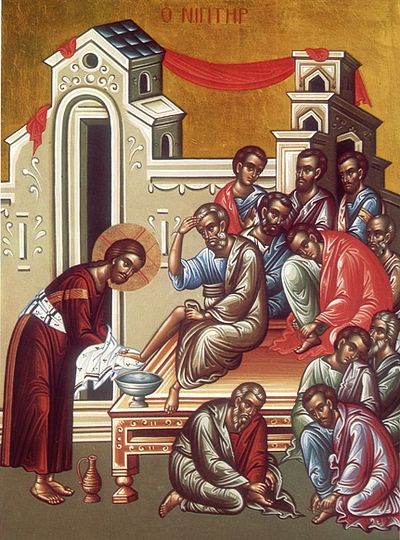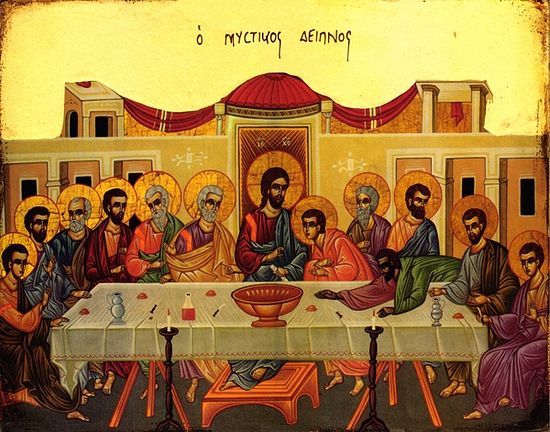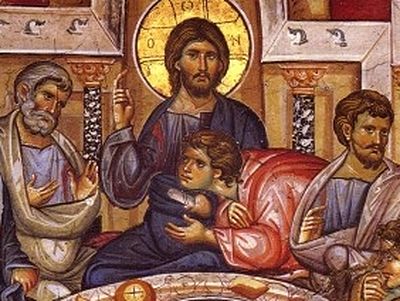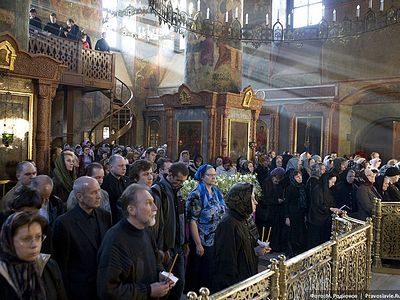The glorious disciples were illumined at the Supper during the washing of the feet, but ungodly Judas was darkened by the disease of avarice, and he delivered Thee, the righteous Judge, to lawless judges. See, O lover of money, how for money’s sake he hanged himself. Flee from the greed which made him dare to do such things against his Master. O Lord, who art good towards all men, glory to Thee.
Troparion
Filling Thy cup of salvation with joy, O loving Lord, Thou hast made Thy disciples drink from it. For Thou offerest Thyself in sacrifice, crying: “Drink My Blood, and ye shall be firmly established in the faith.”
Canticle three of the canon
Humbling Thyself in Thy compassion, Thou hast washed the feet of Thy disciples, teaching them to take the path which as God Thou yielded then to the divine command, and earnestly entreated Thee that we may be granted Thy great mercy.
Sessional hymn
The traitor takes the Bread in his hands, but stretches them out secretly to receive the price of Him who fashioned man with His own hands. For Judas, slave and deceiver, still repented not.
Let us all drew near in fear to the mystical table, and with pure souls let us receive the Bread; let us remain at the Master’s side, that we may see how He washes the feet of the disciples and wipes the with a towel; and let us do as we have seen, subjecting ourselves to each other and washing one another’s feet. For such is the commandment that Christ Himself gave to His disciples; but Judas, slave and deceiver, paid no heed.
Kontakion and Ikos
About the Icon: The Last Supper
Christ is the central figure. St. John the Beloved (Evangelist, Theologian) is the figure seated to the right of Christ. Judas Iscariot the Betrayer is depicted leaning over the table and dipping into the dish (Matthew 26:20-25).
 Icon of the washing of the feet
Icon of the washing of the feet
About the Icon: The Washing of the Disciples Feet
Christ is pictured on the left side of the Icon, washing the feet of a disciple in a basin. Saint Peter, the chief disciple, is depicted seated, asking Christ to wash "not only my feet, but my hands and my head also." (John 13:9). The other disciples are pictured loosening their sandals.
Scriptural references
Epistle: I Corinthians 11:23-32
Gospel: Luke 22:1-39
The Communion Hymn
Receive me today, Son of God, as a partaker of Thy mystical supper; for I will not reveal Thy Mystery to Thine enemies, nor give Thee a kiss as did Judas. But as the thief I confess to Thee: Lord remember me in Thy kingdom.
Explanation of the Feast
The service of Holy Thursday morning is dedicated exclusively to the Passover Supper, which Christ celebrated with his twelve apostles. The main theme of the day is the meal itself at which Christ commanded that the Passover of the New Covenant is to be eaten in remembrance of Him, of His body broken and his blood shed for the remission of sins. In addition, the Judas’s betrayal and Christ's washing of the disciples' feet are also central to the liturgical commemoration of the day. In cathedral churches it is the custom for the bishop to re-enact the foot-washing in a special ceremony following the Divine Liturgy.
The liturgical celebration of the Lord's Supper on Holy Thursday is not merely the annual remembrance of the “institution” of the sacrament of Holy Communion. The very event of the Passover meal itself was not merely the last-minute action by the Lord to “institute” the central sacrament of the Christian Faith before his passion and death. On the contrary, the entire mission of Christ, and indeed the very purpose for the creation of the world in the first place, is so that God's beloved creature, made in his own divine image and likeness, could be in the most intimate communion with Him for eternity, sitting at the table with Him, eating and drinking in His unending kingdom.
In a real sense, therefore, it is true to say that the body broken and the blood spilled spoken of by Christ at his last supper with the disciples was not merely an anticipation and preview of what was yet to come. In fact it was that what was yet to come—the cross, the tomb, the resurrection on the third day, the ascension into heaven—came to pass precisely so that men could be blessed by God to be in holy communion with Him forever, eating and drinking at the mystical table of His kingdom of which there will be no end.
Suggested activities for families:
Since this Liturgy is usually celebrated on Thursday morning while many are at work or at school, those who are able need to be there to represent those who cannot, whether they be other family members or parishioners in general.
Use the hymns of the day for mealtime prayers, and as a focal point for reviewing the significance of this day.
Use the ABOUT THE ICON section to help your children identify the individuals in the icon.






